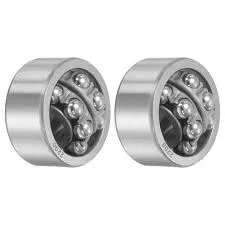
9 月 . 23, 2024 11:30 Back to list
Comparison of Spherical and Cylindrical Roller Bearings Differences and Applications
Differences Between Spherical and Cylindrical Roller Bearings
When it comes to machinery and mechanical applications, bearings play a crucial role in minimizing friction and facilitating smooth rotations. Among the various types of bearings, spherical roller bearings and cylindrical roller bearings are two commonly used configurations. Both serve the purpose of supporting loads and enabling rotational movement, but their designs, functionalities, and applications differ significantly. This article explores the key differences between spherical and cylindrical roller bearings.
Design and Structure
Spherical roller bearings feature an inner ring, an outer ring, and a set of spherical rollers that are arranged in a way to allow for angular misalignment. The rollers can tilt in their raceways, providing a self-aligning function. This design makes them capable of accommodating misalignment due to shaft deflection or housing deformation. On the other hand, cylindrical roller bearings consist of cylindrical rollers that are placed between an inner and outer ring without any self-aligning capability. These bearings typically have a simpler geometry, which allows for a higher load-carrying capacity compared to spherical roller bearings.
Load Capacity
When considering load capacity, cylindrical roller bearings generally outperform spherical roller bearings. This is due to the larger contact area between the cylindrical rollers and the raceways, which allows them to support heavier loads. Moreover, cylindrical roller bearings have a linear contact pattern that results in reduced stress on the contact surfaces. In contrast, while spherical roller bearings can accommodate both radial and axial loads, they may not handle the same level of heavy loads as their cylindrical counterparts.
Misalignment Tolerance
One of the most significant advantages of spherical roller bearings is their ability to tolerate misalignment. In applications where shafts may not be perfectly aligned due to manufacturing tolerances or operational wear, spherical roller bearings can handle these discrepancies. Their spherical design enables the rollers to adjust their position within the raceways. Conversely, cylindrical roller bearings require precise alignment to function effectively without premature wear or failure, making them more suitable for applications where alignment is guaranteed.
Speed Capabilities
difference between spherical and cylindrical roller bearing

Cylindrical roller bearings are known for their high-speed capabilities. Due to their design, they tend to produce less friction than spherical roller bearings, which allows for smoother and faster rotations. This makes cylindrical roller bearings a preferable choice in applications like electric motors, gearboxes, and high-speed machinery. Spherical roller bearings, however, may exhibit higher friction levels due to the angle of the rollers within their raceways, thereby limiting their maximum speed.
Applications
The choice between spherical and cylindrical roller bearings often boils down to the specific application they are intended for. Spherical roller bearings are commonly found in applications where misalignment is likely, such as in certain automobile components, heavy machinery, and mining equipment. They are also utilized in situations where equipment may undergo severe impacts or vibrations.
Cylindrical roller bearings, on the other hand, are predominantly used in applications involving high speeds and heavy radial loads. These bearings are frequently found in electric motors, compressors, and various industrial machinery where alignment can be maintained with precision.
Maintenance and Durability
Both types of bearings require regular maintenance to ensure optimal performance and longevity. However, given their different structures, maintenance practices may vary. Spherical roller bearings may need more frequent inspections for misalignment, while cylindrical roller bearings should be checked for wear and lubrication due to their higher operational speeds.
In terms of durability, both bearing types can offer extended service life when correctly maintained. However, the specific operating conditions and load requirements will ultimately dictate which type may last longer in a given application.
Conclusion
In conclusion, while both spherical and cylindrical roller bearings serve essential functions in mechanical applications, their designs, load capacities, misalignment tolerance, speed capabilities, and typical applications differ significantly. When selecting between the two, engineers and designers must consider the specific operational demands and conditions to choose the most suitable bearing type for their needs. Understanding these differences is key to ensuring the reliability and efficiency of machinery and equipment.
Latest news
-
Unlocking Efficiency with Spherical Roller Bearings
NewsOct.29,2024
-
The Ultimate Guide to Thrust Ball Bearings
NewsOct.29,2024
-
The Power of Thrust Roller Bearings: Engineered for Excellence
NewsOct.29,2024
-
The Power of Deep Groove Ball Bearings for Your Application Needs!
NewsOct.29,2024
-
The Power and Performance of Cylindrical Roller Bearings
NewsOct.29,2024
-
High-Quality Ball Bearing Manufacturing Machines
NewsOct.29,2024
